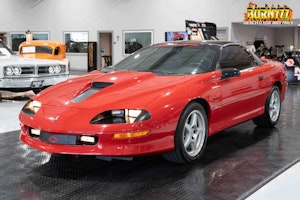Media | Articles
Step-by-step guide to winterizing your car
Before storage
- Select a dry, dark location for storage — preferably with limited access. Concrete flooring is best at keeping away moisture. If you must store your car on a dirt floor, place a plastic barrier under the vehicle, and place carpet pieces or plywood under the tires.
- Give the vehicle a good wash/wax. Putting on and removing a vehicle cover will lead to unwanted scratches if the car is dirty.
- Fill the fuel tank (preferably with premium) and add fuel stabilizer. Be sure to run the vehicle to move fuel stabilizer into the carburetor, fuel rails, injectors, etc. The fuller the tank, the less room there will be for air, which carries moisture that can lead to fuel contamination and possibly rust within the tank.
- Change the oil and filter right before putting away the vehicle. The clean oil will reduce the risk of harmful contaminants working away at your engine during hibernation — and you’ll be ready to go in spring.
- Check the antifreeze.
- Add air to the tires.
- If you’re storing your car offsite, some insurance companies require you to report the address of the offsite location. Check with your insurer to determine your policy’s requirements.
When storing
- Place baking soda refrigerator packages in the interior and trunk areas.
- To keep insects and vermin out of the car, put a plastic bag over the air cleaner/air inlet and exhaust pipe(s). You also can cover these with aluminum foil and tape securely. Place mothballs in the tailpipe and around the outside of the car, or insert steel wool in the tailpipe.
- Place the vehicle on jack stands. This step avoids tire flat spots and adds longevity to the suspension because it is not supporting the vehicle’s weight during storage.
- For your battery, take one of the following actions: Unhook the battery by removing the negative cable first and store it separately — never on a concrete floor and preferably where it will not freeze; or leave the battery in the car and put a battery tender on it, if there is power available. That way if you want to start it a few times in the winter you don’t have to put the battery in and out.
- Close all of the windows.
- If the vehicle will be exposed to freezing temperatures, be certain no personal items that may freeze or burst are left in the vehicle.
- There are varying theories about periodically starting the vehicle. This writer feels unless you get the engine up to operating temperature for a good 10-plus minutes to burn off the water vapors that initially develop at startup-cold operation, starting is not a good idea. Anything less will leave water in the combustion chamber and all exhaust components.
Bringing your baby back to life
- Charge the battery for a solid 24 hours. When returning the battery to the vehicle, attach the positive cable first.
- Once your car is uncovered, inspect it for any signs of insect or vermin damage.
- Remove the baking soda units. If you forget them, they may spill during driving.
- It’s a good idea to check for floor leaks, check all fluid levels, and check the tire pressures.
- Remove plastic bag (aluminum foil) from over air cleaner/air inlet and exhaust pipe(s).
- Apply the brakes ensure they work and that you have a good pedal. The steel brake lines can rust out and leak, and vermin can chew through the rubber brake hoses.
- Start the vehicle and check for any fluid leaks.
- Give it some extra time to warm up, and check the lights, horn, etc., while the temperature begins to rise. Drive it slowly for a mile or so. Some components such as transmissions and rear-ends require movement for full/proper lubrication.
- After driving a bit, check it again for leaks, etc.
- Your car cover may have become dusty over the long winter months — give it a good cleaning according to the manufacturer’s instructions.
- Lastly, but most importantly, do a burnout for me!
Marketplace
Buy and sell classics with confidence










I start and move mine every 2-3 weeks during the winter letting it run for a minimum of 10 minutes never had any issues
I personally avoid a car cover as rodents appear to love dark places and it seems to encourage them to utilize your vehicle as a permanent home! I prefer a little dust over the vermin. I open the truck and hood of the car and utilize all the other recommendations noted. As an aside, I have had excellent results placing dryer sheets throughout the vehicle. Thanks
I avoid a car cover as rodents appear to love dark places and it seems to encourage them to make your vehicle their home. I prefer a little dust over the vermin. I open the truck and hood of the car and utilize all the other recommendations noted. As an aside, I have had excellent results placing dryer sheets throughout the vehicle. Thanks
The one upside to winter storage is if it’s accessible you can work on it. this winter I’m getting rid of my rear main seal leak and refreshing the top end of my motor.
Good info, thanks. This will be the first time storing my baby in possibly harsh winter conditions. It has it’s own attached garage but it’s not heated. I plan on taking it out on those dry nippy days so the fuel stabilizer and non ethanol fuel is a great idea
I’ll install the headliner that I was going to install last winter, and the winter before. From what I hear of headliner installs, that should keep me busy from November till March. I’ll then likely take it to an upholstery shop and get it done properly…
any ideas on how to keep mice OUT of the interior??? mothballs “freeze” & “fabric” softeners become a nest….
Leave air intake on recirculate not fresh air to keep mice out!!
Dryer sheets have worked well for me – the nasty cheapo ones from the dollar discount store. One box per car, scattered around, esp. under the seats and over the sun-visors
Try Grandpa Gus’s mouse rpellent
I read somewhere to put comet around the tires
I use cotton balls with a few drops of peppermint oil. Spread them throughout the car. I had rodent problems before this, none since.
Carcapsule
whole cloves in pie platew
I use peppermint extract throughout the interior and motor area. Put some on cotton pads and it will deter the little creatures as they don’t like the smell. It doesn’t leave stains like cloves. It has been successful for me with all our treasured items!
I used dryer softener sheets last year. Worked just fine and had a nice smell inside in the spring.
OK – we did this years ago with a car stored in an unheated pole barn: Put all 4 wheels up on jacks*, but BEFORE you do that, place the jacks on old oil drain pans, filled with about 1/2 inch of old oil. That way the mice need to climb the oil pan, swim thru the old oil “moat” (which they will probably not do) and then, with their oily little mitts, try to climb up the jackstands. Worked for us. (*make sure the tires are at least 4 to 6 inched off the ground)
I bought a cover from Amazon that is called Cover Seal is has sand around the bottom and no rodents can get under it . It’s worked for me every yr but put a soft cover on it first then that cover so it don’t scratch the car . Good luck
Try using peppermint oil. Dilute a few drops in a little water, then spray your interior carpets.(they hate the smell) I also pour a couple oz. in small dishes and set them in the engine bat, and on the seats of car. Don’t forget the trunk. Leave the cover off the car, disconnect the battery they love the wires if power is connected.
I appreciate all the information from haggerty and drivers. This would be my first time storing my 2011 GT500 I am nervous about leaving it in the cold but you guys gave me some great tips thanks.
I decided to get a Car Capsule for my rust-prone Porsche 911. Its in an unheated garage in the northeast rustbelt. It was ~$500 and so it paid for itself in a couple years vs offsite storage. It has a fan that keeps air moving. I also put a cover on it and the base is oil resistant. It does take up a lot of space as it is bulbous. I sleep a little better I guess
I use Cab Fresh for the interior and under the hood on my ’76 vette. I also add some Bounce laundry sheet under the hood. In the air cleaner, and the wiper well. Works better and smells better than moth balls.
I also received a tip from a Chevy engineer about lifting the car off the tires. He reccomends not lifting it as the suspension was set up to support the weight, not hang in the air. His recconendation is to put down 4 sheets of plastic 18″x18″, place carpet padding same size on next, then a final layer of thick carpet scraps all the same size and park your vehicle on the squares. The tires will create a curved spot to rest on…
I agree with this method
What’s the purpose of the baking soda? Don’t forget your Bounce fabric sheets!
reduces/absorbs odour (musty smell) from sitting over several months closed off from fresh air
I use 2 inch thick pink styrofoam insulation under the tires. Tires sink into it, and it blocks moisture from the concrete.
I’m not winterizing mine I am taking it to Florida to drive that sucker
I use moth balls to keep rodents out seems to work
I use a few bars of Irish Spring in key areas.
I have always wondered how many of Tom Cotter’s barn finds started out a a car that was put in the garage or barn for a “few weeks” in the fall with the plan to work on it that winter and 30 years later…
I’m putting my MGB Vintage racer up for the winter and in addition to all of the really good advice above, there are a few things to do differently for a race car. If you have an AFF fire system, remove the bottle and store indoors if the car can see freezing temperatures, the main ingredient in AFF is water, so the bottle can freeze and burst. This is a good time to check expiration dates on safety gear, seat belts, fire system, fuel cell, transponder subscription, etc. Right now, it is better to have 4 or 5 months lead time for these items rather than scrambling a few weeks before the first race of the season. If your race car has a fuel cell, the manufacturer likely recommends you drain the fuel cell completely to better preserve the rubber composite bladder and the fuel cell foam. This is the opposite of the recommendation to “fill it full” for street-driven cars. I add stabilizer to the fuel and run the car for a bit before I drain the cell, fuel lines, filters and carb float bowls to make sure any residual fuel in the system is treated. I also like to siphon off the brake fluid in the master cylinder reservoirs, replace with fresh fluid then give the brakes/clutch a good bleed to make sure I’ve drawn fresh fluid all the way through the system, less chance of water contamination. Then I manually back off the brake pads so they don’t rust to the rotors. I also keep the car on old street wheels and tires so its easy to move around the shop and the race tires can be bagged and stored flat. Finally, I always doubted the recommendation to change the oil for storage. The principal seemed sound, but I hated the idea of fresh oil sitting in the sump for 6 months. I contacted the manufacturer of the oil I use (Penngrade 20-50) and they confirmed that the oil in the sump would not be degraded significantly in winter storage. So, after draining the sump, cooler and lines, I added fresh oil, removed the spark plugs and ran up oil pressure on the starter to make sure all the oil galleys were charged, but without introducing combustion contaminants by starting the engine on the chokes. I really try NOT to start the car in storage – just becomes a condensation generator. In fact, if your race car has a muffler, I recommend removing it and pouring out all the condensation water inside the can. Its a lot of fussy work, but nothing too difficult or expensive and for me, it really helps to have things ready to go for that first race in the spring.
If you are storing all winter, definitely use the best gasoline available and use a fuel stabilizer. HappyFuel Premium Fuel Stabilizer has the best performing antioxidants available.